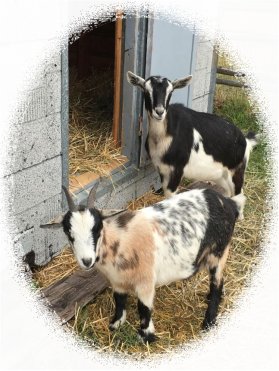
JOHNES Status: Tested and Clean 2020.
CAE Status: Tested and Clean 2019.
C.L Status: Never an abscess to date.
We have done testing for Johnes and CAE in 2018, and 2019, and will be testing again in 2020.
Some of our herd has also been tested for brucellosis and TB as per import requirements. We will discuss the Big 3 diseases here though and why we test for them. We hope that this will help to ensure that other breeders will also begin to test if they currently aren't doing so. These diseases can be eradicated if we would just test and cull infected animals.
Costs for testing vary according to vet fees and lab testing fees. We use our vet for CAE and CL abscess testing because I have not learned how to draw blood, and I want a professional handling any/all abscesses. I do the fecal collection/packing/shipping to the government animal health lab in Abbotsford, BC, for johnes PCR testing. Approximate cost per animal for CAE and Johnes annual testing is $150 per animal. This includes vet fees, lab fees, shipping fees, my own collection and shipping supplies.
Our main reason for testing is for our own peace of mind. However, we also believe that all responsible breeders should test to help ensure they are selling healthy animals to their buyers. A breeder can say all day long they have a healthy herd but in all reality they don't know that. Even with testing, disease can be introduced with any new purchase, or even a passing deer. Even the feed they buy to feed their animals could contain some of these diseases.
A big pet peeve of ours are breeders and/or sellers who are aware they have had disease in their herd, or have had animals exposed to disease, or their land exposed, and are not disclosing this publicly or even privately to potential buyers. This is wrong in my opinion.
We are honest and proud enough to admit that we have indeed had 2 animals test positive, 1 for Johnes and 1 for CAE, in 2018 when we first started testing and bringing in breeding stock. We are happy to say that we had in place a great quarantine practise that saved our land being exposed, and saved the herd from being exposed. Both animals were caught while in quarantine, the johnes positive doe was euthanized the day after the test results came in, and the cae positive doe was immediately sent for slaughter.
JOHNES
Johnes is a fatal gastrointestinal disease of goats and other ruminants such as cattle, sheep, elk, deer and bison. It is caused by the bacterium Mycobacterium avium subspecies paratuberculosis aka MAP. The MAP organism is most commonly passed in the manure of infected animals.
The infection usually spreads from infected adult goats to kids and occurs when a young animal swallows the organism via water, milk, or feed that has been contaminated by the manure of infected animals.
Domestic animals such as goats, sheep, cattle and Bison can infect wild herds of ruminants such as deer, elk, and bison and vice versa, wild herds can infect our domestic herds. This is the reason why is so very important for all breeders to test for this incurable, and always fatal disease.
An animal that appears perfectly healthy can indeed be infected and spreading the disease around your farm, and through your herds. It can stay in the ground for a year or more. Not even a vet can tell by looking at an animal in the early stages that it is carrying johnes or not. Only in the late stages can you tell by looking at the animal.
There are two tests currently available to test your herd for Johnes, the blood serum test that is looking for antibodies in the blood for the disease or the PCR fecal test that looks for the bacteria being shed by an infected animal in its manure. This usually will detect johnes before the blood serum test will. Which is why we primarily use the PCR testing route.

One of these two does in the photo to the left was Johnes positive and one was not. Can you tell just by looking at these two goats who was positive and who was negative? Photo was taken on another farm before they arrived at my farm.
C.A.E
Caprine Arthritis Encephalitis aka CAE is a contagious viral disease of goats. The disease is typically spread from mother to kid through ingestion of infected colostrum or milk. CAE virus may also be spread through contact with body secretions including blood and feces of infected goats
However, CAE doesn't live very long in the environment. Usually as soon as air dries the secretions, the virus is dead.
The test for CAE is a blood serum test. Blood is drawn and sent away to an accredited lab by our veterinarian.
C.L
Caseous Lymphadenitis or CL is an infection of sheep and goats caused by Cornebacterium psuedotuberculosis bacteria. This contagious disease is best known for the abscesses in the external lymph nodes of the neck and abdomen. However, CL abscesses can also form in the lungs, udder, liver and kidneys.
Goats become infected when the bacteria enters through an open wound or mucous membranes such as eyes, nose, and mouth. Swollen Lymph nodes are typically not detectable for 2 to 6 months after initial infection.
As lesions in the lymph nodes grow, abscesses containing creamy white, yellow or greenish colored pasty pus, rich in bacteria form. These abscesses displace normal tissue and can cause difficulty breathing, eating, and ruminating.
The infection is transmitted directly to other herd members when the external abscess ruptures as the increase in size. CL can live in the environment for a number of years.
The best way to test for CL is to test the pus from an abscess.